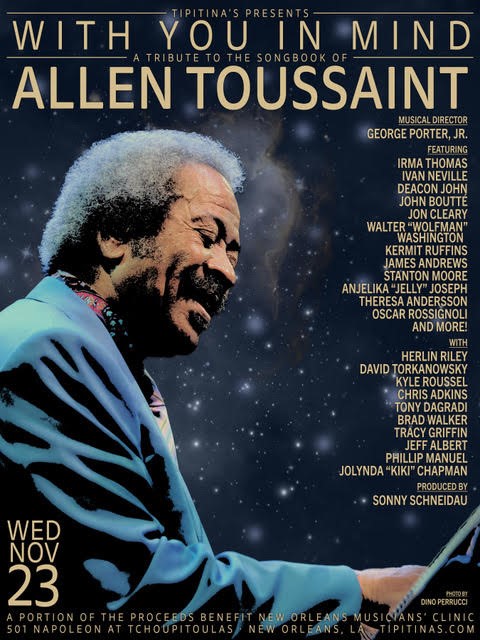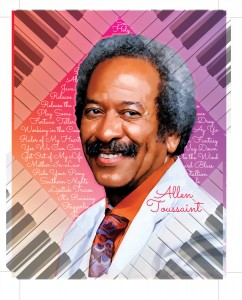Tipitina’s tribute to Allen Toussaint’s songbook on November 23 is named after the Toussaint song “With You In Mind.” The watershed event will be produced by Sonny Schneidau, with musical directrion by George Porter, Jr. The show will feature performances by a host of artists including Irma Thomas, Ivan Neville, Deacon John Moore, John Boutté, Jon Cleary, Walter “Wolfman” Washington, Kermit Ruffins, James Andrews, Stanton Moore, Anjelika “Jelly” Joseph, Theresa Andersson, Oscar Rossignoli, and more.
 Few people have left as deep a footprint on the history of New Orleans music as Allen Toussaint. He was a performer so versatile he ghosted for Huey “Piano” Smith and Fats Domino in his early days on the scene. He is also a songwriter on a talent level with Lennon/McCartney. Perhaps most importantly, Toussaint was a producer who almost single-handedly turned New Orleans into a hit factory that rivaled anything New York, Los Angeles, Nashville or Detroit could muster at a turning point in popular music history at the dawn of the 1960s.
Few people have left as deep a footprint on the history of New Orleans music as Allen Toussaint. He was a performer so versatile he ghosted for Huey “Piano” Smith and Fats Domino in his early days on the scene. He is also a songwriter on a talent level with Lennon/McCartney. Perhaps most importantly, Toussaint was a producer who almost single-handedly turned New Orleans into a hit factory that rivaled anything New York, Los Angeles, Nashville or Detroit could muster at a turning point in popular music history at the dawn of the 1960s.
Allen Toussaint’s song catalogue is enormous—he certainly was New Orleans music’s Renaissance man. Toussaint not only composed great songs—he was an arranger, producer, and performer who crossed styles with enthusiasm and panache. In 1963, Toussaint wrote and produced “Ruler of My Heart” for Irma Thomas, creating a song with a gentle shuffle of brushes on drums, a lightly strummed guitar, a skipping bassline, and Thomas’s deliciously restrained vocal. Otis Redding would later reinterpret it as “Pain in My Heart,” but in Thomas and Toussaint’s version you can hear New Orleans—stylish, yet ethereal.
Get ready for Tipitina’s tribute to Allen Toussaint’s songbook by getting acquainted with some of his more famous songs.
In the OffBeat book “300 Songs for 300 Years,” several of Toussaint’s songs are covered. Following are some excerpts:
“Fortune Teller” “Lipstick Traces (on a Cigarette) (Benny Spellman, 1960)
The hypnotic Latin-tinged rocker “Fortune Teller” was one-half of a two-sided hit as it shared the Minit platter with the ballad “Lipstick Traces (on a Cigarette).” A former football star at Southern and Clown (as in Huey Smith), the affable Spellman was one of the original Minit artists, coming to the label in a giant talent audition supervised by Allen Toussaint and Minit boss Joe Banashak in 1959.
The Rolling Stones featured “Fortune Teller” in live shows, and it was included on the CD Got Live if You Want It!—Jeff Hannusch
“Mother-in-Law” (Ernie K-Doe, 1961)
A number one, million-seller, “Mother-in-Law” will forever be associated with the larger-than-life Ernie K-Doe. Written by Allen Toussaint, the song’s origin has undergone a colorful debate. “Allen had written it and thrown it away,” claimed K-Doe in 1982. “He had balled it up and threw it in the trash can. I saw it in the garbage can and pulled it out. I looked at the words and said, ‘Hey man this is good. I want to do this.'”—Jeff Hannusch
“All These Things” (Art Neville, 1962)
Perhaps the ultimate New Orleans slow dance, “All These Things” oozes romance, from the languid tempo to the spoken word interlude to the muted trumpet that plays the instrumental hook.—Brett Milano
“Ruler of My Heart” (Irma Thomas, 1963)
After a sassy debut with “Don’t Mess With My Man,” Irma Thomas found her true niche with emotive ballads. Written by Allen Toussaint under his Naomi Neville pseudonym, “Ruler of My Heart” ended the Minit run and may be the most intense song of the lot. “A song like that really sells itself,” Thomas says of the tune—which, like all the Minit singles, was a regional hit but missed the national charts.—Brett Milano
“Java” (Al Hirt, 1963)
You can’t ask for a more mythic New Orleans scene than this: It was early morning after an all-night session and pianist Allen Toussaint broke into this jolly tune, fueled by the fresh coffee and doughnut smells coming from outside the studio; street passersby heard the music and started dancing along. Toussaint confirmed in the notes to a reissue CD that it really did happen that way—and the aroma likely came from the Cafe du Monde, since Cosimo Matassa’s studio was then a few blocks away on Governor Nicholls Street. Toussaint also said that he built the song on the idea of parallel fifths, and that to him it had an Oriental feel. That morning reverie gave “Java” its title—unlike many of the instrumentals on Toussaint’s first album, which his then-manager named after racehorses.—Brett Milano
“It’s Raining” (Irma Thomas, 1963)
From 1963, “It’s Raining” is still one of Irma Thomas’ most recognizable and popular songs, particularly around Orleans Parish. Toussaint (who often composed songs under his mother’s maiden name Naomi Neville) was a virtual conveyor belt of material. Ideas for material often came to him at the oddest time. Toussaint once revealed the inspiration for “It’s Raining” came to him in the bathroom of Cosimo’s studio while he was relieving himself!—Jeff Hannusch
“Working in the Coal Mine” (Lee Dorsey, 1966)
Surely no Allen Toussaint song fit an artist’s demeanor better than “Working in the Coal Mine” did for Lee Dorsey. One of several mid-1960s hits written by Toussaint for Dorsey, “Working in the Coal Mine,” reaching the Top 10, was his biggest. At the time, Toussaint was putting together a funky New Orleans studio band that consisted of a quartet of musicians who would later be called the Meters. That band played on “Working in the Coal Mine” and all of Dorsey’s later records.—Jeff Hannusch
“Yes We Can Can” (Allen Toussaint, 1970)
A sense of social and racial injustice infused Allen Toussaint’s writing in the late ’60s. “Yes We Can” is a rousing song that trusted in humanity to come together and get it right. Its still-resonant message—“We got to help each man be a better man, with the kindness that we give”—is propelled by its Dorsey/Toussaint vocal tradeoffs and a trademark Meters groove.—Brett Milano
“What Is Success” (Allen Toussaint, 1970)
“What Is Success” introduces the philosophical tone of his solo work to come, taking a couple hints from the records Curtis Mayfield was making at a time. The studio players (not the Meters this time, but most of Dr. John’s studio crew) give it a suitable slow burn. His plainspoken lyric speaks volumes about the struggles of black society at the time, asking whether joining the mainstream was the answer—“What is success, is it doing your thing, or do you join the rest?” The song became famous when Bonnie Raitt recorded it in 1974.—Brett Milano
“Southern Nights” (Allen Toussaint, 1975)
“Southern Nights” was obviously Toussaint’s favorite song (he played it at virtually every show, and even dubbed himself “the Southern Knight” on his website in the 2000s. Thanks to Glen Campbell, it was the only Toussaint song to top both the pop and country charts.
The song was expanded considerably when Toussaint performed it on solo tours in the 2010s. In a beautifully constructed monologue, Toussaint told of the moods that inspired the song—visiting family out in the country, sitting on the porch with no electricity on, feeling confused by the stories the old men and women were telling, but feeling that “there was someone on this porch that could do something about anything I ever needed.” Since Toussaint seldom said more than a few words onstage, the monologue was surprising at the time. Heard today, it sounds like the clearest look into his heart he ever offered.—Brett Milano
And one song Toussaint didn’t write:
“Lady Marmalade” (Labelle, 1974)
It was producer Allen Toussaint’s idea to cut the song with Labelle, using three-quarters of the Meters in his studio band (the drummer is Herman “Roscoe” Ernest, not Zigaboo Modeliste). Toussaint’s stamp is strong enough that many assume he wrote it, especially as the song showed up regularly in his live sets for decades afterward.
Few songs evoke the sexiness of New Orleans better than this tune, about an innocent guy who finds true love (or something that temporarily looks like it) with a streetwalker. “Lady Marmalade” was just risqué enough to get on the radio, giving impressionable ’70s teens a few cheap thrills—and in more than a few cases, the first French phrase they ever learned.
The song was written by Bob Crewe (member and songwriter of most of the Four Seasons songs) and Kenny Nolan. Crewe and Nolan team also wrote Frankie Valli’s decidedly unfunky “My Eyes Adored You.”—Brett Milano
There are a million other songs—the most difficult part of organizing the Tipitina’s show will be what songs to choose.
Tipitina’s tribute Allen Toussaint’s songbook will take place at Tipitina’s, 501 Napoleon Ave., Wednesday, November 23, 2022, at 8 p.m. A portion of the proceeds will benefit the New Orleans Musicians’ Clinic. Tickets are available here.





